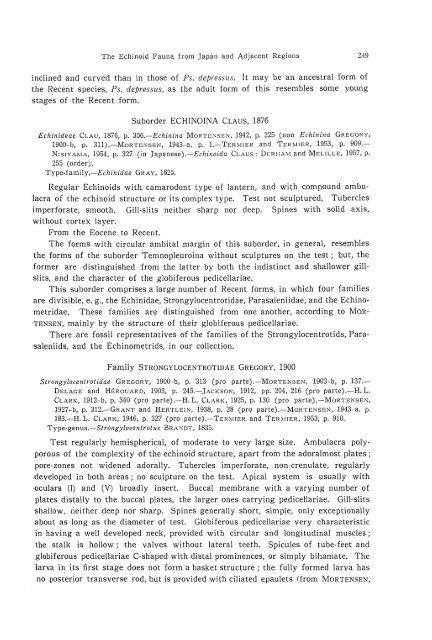the echinoid fauna from japan and adjacent regions part i
the echinoid fauna from japan and adjacent regions part i
the echinoid fauna from japan and adjacent regions part i
You also want an ePaper? Increase the reach of your titles
YUMPU automatically turns print PDFs into web optimized ePapers that Google loves.
The Echinoid Fauna <strong>from</strong> Japan <strong>and</strong> Adjacent Regions 249<br />
inclined <strong>and</strong> curved than in those of Ps. depressus. It may be an ancestral form of<br />
<strong>the</strong> Recent species, Ps. depressus, as <strong>the</strong> adult form of this resembles some young<br />
stages of <strong>the</strong> Recent form.<br />
Suborder ECHINOINA CLAUS, 1876<br />
Echinideae CLAU, 1876, p. 356.-Echinina MORTE;'\SEN, 1942, p. 225 (non Echinina GREGORY,<br />
1900-b, p. 311).-MoRTENSEN, 1943-a, p. l.-TERYIlER <strong>and</strong> TERlvIIER, 1953, p. 909.<br />
NISIYAlvIA, 1954, p. 327 (in Japanese).-Echinoida CLAUS: DCRHA\I <strong>and</strong> MELILLE, 1957, p.<br />
255 (order).<br />
Type-family.-Echinidae GRAY, 1825.<br />
Regular Echinoids with camarodont type of lantern, <strong>and</strong> with compound ambulacra<br />
of <strong>the</strong> <strong>echinoid</strong> structure or its complex type. Test not sculptured. Tubercles<br />
imperforate, smooth. Gill-slits nei<strong>the</strong>r sharp nor deep. Spines with solid axis,<br />
without cortex layer.<br />
From <strong>the</strong> Eocene to Recent.<br />
The forms with circular ambital margin of this suborder. in general, resembles<br />
<strong>the</strong> forms of <strong>the</strong> suborder Temnopleuroina without sculptures on <strong>the</strong> test; but, <strong>the</strong><br />
former are distinguished <strong>from</strong> <strong>the</strong> latter by both <strong>the</strong> indistinct <strong>and</strong> shallower gillslits,<br />
<strong>and</strong> <strong>the</strong> character of <strong>the</strong> globiferous pedicellariae.<br />
This suborder comprises a large number of Recent forms, in which four families<br />
are divisible, e. g., <strong>the</strong> Echinidae, Strongylocentrotidae, Parasaleniidae, <strong>and</strong> <strong>the</strong> Echinometridae.<br />
These families are distinguished <strong>from</strong> one ano<strong>the</strong>r, according to MOR<br />
TENSEN, mainly by <strong>the</strong> structure of <strong>the</strong>ir globiferous pedicellariae.<br />
There are fossil representatives of <strong>the</strong> families of <strong>the</strong> Strongylocentrotids, Para<br />
'saleniids, <strong>and</strong> <strong>the</strong> Echinometrids, in our collection.<br />
Family STRONGYLOCENTROTIDAE GREGORY, 1900<br />
Strongylocentrotidae GREGORY, 1900-b, p. 313 (pro <strong>part</strong>e).-MoRTENSEN, 1903-b, p. 137.<br />
DELAGE <strong>and</strong> HEROUARD, 1903, p. 245.-JACKSON, 1912, pp. 204, 216 (pro <strong>part</strong>e).-H. L.<br />
CLARK, 1912-b, p. 340 (pro <strong>part</strong>e).-H. L. CLARK, 1925, p. l30 (pro <strong>part</strong>e).-MoRTENSEN,<br />
1927-b, p. 312.-GRANT <strong>and</strong> HERTLEIN, 1938, p. 28 (pro <strong>part</strong>e).-MoRTE='iSEN, 1943-a, p.<br />
183.-H. L. CLARK, 1946, p. 327 (pro <strong>part</strong>e).-TERyIlER <strong>and</strong> TER\IIER, 1953, p. 910.<br />
Type-genus.-Strongylocentrotus BRA:\DT, 1835.<br />
Test regularly hemispherical, of moderate to very large size. Ambulacra polyporous<br />
of <strong>the</strong> complexity of <strong>the</strong> <strong>echinoid</strong> structure, a<strong>part</strong> <strong>from</strong> <strong>the</strong> adoralmost plates;<br />
pore-zones not widened adorally. Tubercles imperforate, non-crenulate, regularly<br />
·developed in both areas; no sculpture on <strong>the</strong> test. Apical system is usually with<br />
·oculars (1) <strong>and</strong> (V) broadly insert. Buccal membrane with a varying number of<br />
plates distally to <strong>the</strong> buccal plates, <strong>the</strong> larger ones carrying pedicellariae. Gill-slits<br />
shallow, nei<strong>the</strong>r deep nor sharp. Spines generally short, simple, only exceptionally<br />
about as long as <strong>the</strong> diameter of test. Globiferous pedicellariae very characteristic<br />
in having a well developed neck, provided with circular <strong>and</strong> longitudinal muscles;<br />
<strong>the</strong> stalk is hollow; <strong>the</strong> valves without lateral teeth. Spicules of tube-feet <strong>and</strong><br />
globiferous pedicellariae C-shaped with distal prominences, or simply bihamate. The<br />
larva in its first stage does not form a basket structure; <strong>the</strong> fully formed larva has<br />
no posterior transverse rod, but is provided with ciliated epaulets (<strong>from</strong> MORTENSEN,












